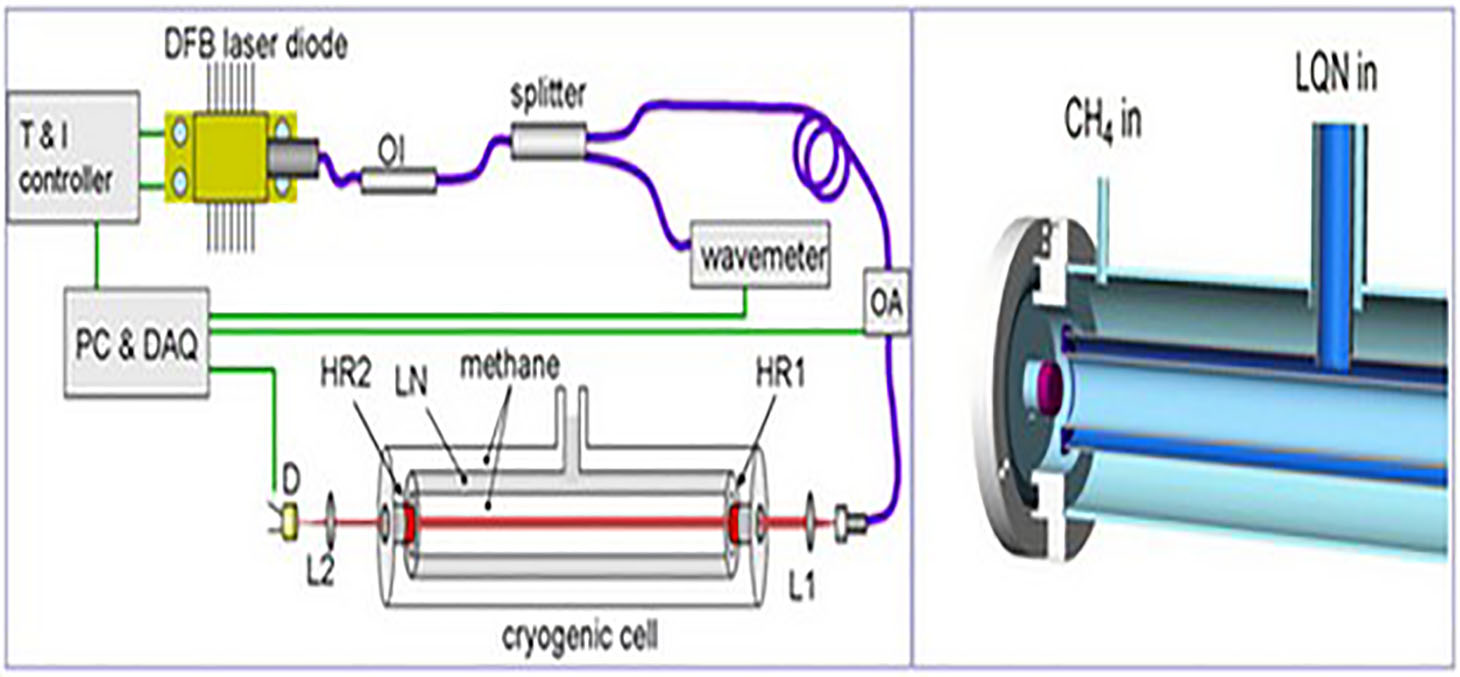- Share
- Share on Facebook
- Share on X
- Share on LinkedIn
The CRDS (Cavity Ring Down Spectroscopy) technique is a highly sensitive optical technique which consists of injecting photons into a high finesse optical cavity, i.e. one composed of mirrors of very high reflectivity R, and measuring their lifetime, generally of the order of a few µs to several hundred µs. This lifetime depends on the reflectivity of the mirrors - considered as constant at order 0 - but also on the intracavity losses such as those induced by an absorbing gas. Measuring these losses as a function of wavelength allows us to obtain the absorption spectrum of the gas in question.
More precisely, a high finesse optical cavity is a Perot-Fabry standard whose transmission peaks, equidistant in the spectral domain (longitudinal modes), are extremely fine (sometimes a few hundred Hz). Only the quasi-monochromatic light of a laser allows to efficiently inject photons. In our CRDS experiments we couple optical cavities to transverse (TEM00) and longitudinal (monochromatic) single mode lasers [1]. A fast photodiode, placed at the output of the cavity, allows to measure the amount of transmitted light. When the laser emission coincides with one of the longitudinal modes of the cavity, a fraction of the light is transmitted. When the transmitted intensity exceeds a certain threshold, the injection of photons into the cavity is abruptly cut off and the decay time (ring down) of the light intensity is recorded using the same photodiode. This decay time is directly related to the absorption coefficient (due to the gas present in the cavity) at the wavelength emitted by the laser. By scanning the laser, a spectrum representing the absorption coefficient as a function of the wavelength (absorption spectrum) is recorded. Thanks to the extreme reflectivity of the mirrors (1-R 1 × 10-5) we can reach in a 1m40 cavity a sensitivity equivalent to that which would be obtained conventionally with an absorption cell several thousand kilometers long.
In addition to its very high sensitivity, reaching 5×10-11 cm-1 in routine for the minimum detectable absorption coefficient, the CRDS technique presents a large dynamic range (over 4 to 5 orders of magnitude) and an intrinsic insensitivity to laser source intensity fluctuations.
We currently have two similar CRDS spectrometers that differ in their operating range between 1.26 and 1.45 µm for one and 1.45 - 1.72 µm for the other. A set of nearly one hundred fibered DFB laser diodes provides full coverage of these two spectral ranges.
(R≈99.999%)
CW-CRDS à 80 K
We have developed a third spectrometer coupled to a cryogenic cell[2],[3]. This unique innovation allowed us to record methane spectra at a temperature close to that of liquid nitrogen (-190 °C or 80 K).
This cryogenic CRDS cell has a very particular geometry which allows the gas to flow freely between the cryogenic tube, the mirrors and the external enclosure. Inside the cryogenic tube, made of a double wall in which liquid nitrogen circulates (represented in dark blue), the gas is "thermalized" at the temperature of the liquid nitrogen while between the cryogenic tube and the external wall it plays almost the role of a thermal insulator because of its low pressure (typically < 10 mbar).

A set of spectra recorded continuously during a cooling-warming cycle of the cryogenic cell allows to observe the important evolution of the methane spectrum with temperature around 6096 cm-1.
References
[1] J. Morville, D. Romanini, A.A. Kachanov, M. Chenevier, "Two schemes for trace detection using cavity ringdown spectroscopy", Applied Physics B - Laser and Optics, Springer Verlag, 2004, 78 (3-4), pp.465-476. ⟨10.1007/s00340-003-1363-8⟩
[2] Samir Kassi, Bo Gao, Daniele Romanini, Alain Campargue, "The near-infrared (1.30–1.70 μm) absorption spectrum of methane down to 77 K", Physical Chemistry Chemical Physics, Royal Society of Chemistry, 2008, 10 (30), pp.4410-4419. ⟨10.1039/b805947k⟩
[3] Samir Kassi, Daniele Romanini, Alain Campargue, "Mode by Mode CW-CRDS at 80 K: Application to the 1.58 μm transparency window of CH 4", Chemical Physics Letters, Elsevier, 2009, 477, pp.17-21. ⟨10.1016/J.CPLETT.2009.06.097⟩
Actors
Samir KASSI
Daniele ROMANINI
- Share
- Share on Facebook
- Share on X
- Share on LinkedIn